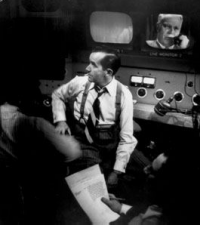Saw It Then: Murrow's "See It Now" Turns 60
 On November 18, 1951, journalist Edward R. Murrow united the states of America. On the premiere episode of See it Now, Murrow showcased technology made possible by the recently completed transcontinental coaxial cable, which linked the East and West Coasts of the United States and made live video transmission between the two possible. As Murrow sat in CBS' New York City Studio 41, director Don Hewitt brought up live video feeds of the Brooklyn and Golden Gate bridges on side-by-side monitors. With this then-stunning technological feat began one of the most respected news programs of all time.
On November 18, 1951, journalist Edward R. Murrow united the states of America. On the premiere episode of See it Now, Murrow showcased technology made possible by the recently completed transcontinental coaxial cable, which linked the East and West Coasts of the United States and made live video transmission between the two possible. As Murrow sat in CBS' New York City Studio 41, director Don Hewitt brought up live video feeds of the Brooklyn and Golden Gate bridges on side-by-side monitors. With this then-stunning technological feat began one of the most respected news programs of all time.
By 1951 Murrow was already an internationally known newsman thanks to his CBS radio reports on Hear it Now. He and producer Fred Friendly adapted the program for television in the resulting, aptly-titled See it Now, TV's first news-magazine. Known for no-nonsense, gutsy reporting, See it Now tackled subjects that other news programs of the day didn't dare broach. Murrow and Friendly took on the country's mounting fears of communist threats in the memorable episode featuring "The Case of Milo Radulovich," in which Murrow delved into the story of how a U.S. Air Force Lieutenant was discharged because his father and sister were alleged communists. And in "A Report on Senator Joseph R. McCarthy," video and audio footage of McCarthy demonstrated the questionable validity of the Senator's accusations of supposed communists within American society. The program helped usher in the downfall of the famed Senator from Wisconsin.
Several of the Archive's interviewees worked on See It Now, and vividly recalled "A Report on Senator Joseph R. McCarthy." See it Now producer Joseph Wershba discussed the episode in depth:
And See it Now editor Mili Lerner Bonsignori described the episode and McCarthy's response:
Edward R. Murrow is remembered not only for his bold reporting, but for his eloquence, too. His See it Now narration was moving and poignant, his trademark sign-off "Good Night and Good Luck" reassuring, and his Shakespeare quotes relevant and informative. Murrow and See it Now still remain the pinnacle of broadcast journalism for many news-people and viewers alike. Archive interviewees Howard K. Smith, Don Hewitt, John Frankenheimer (all contributors to the show) and comedy writer James L. Brooks each spoke reverently about both the program and its host. For as The Bard might say, never was there a more courageous news show, than that of See it Now with Edward R. Murrow.
- Adrienne Faillace
Visit our See it Now show page
